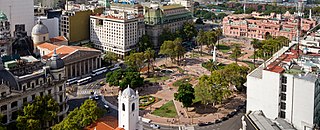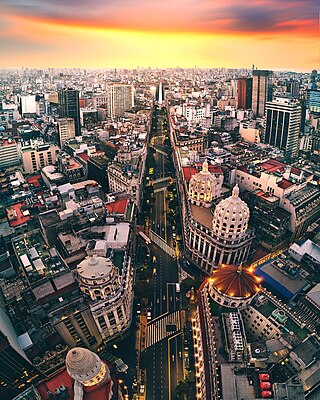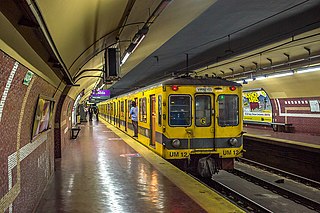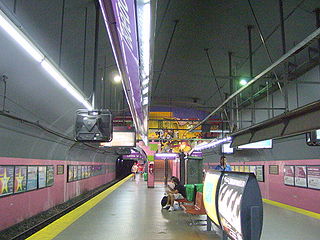
The Plaza de Mayo is a city square and the main foundational site of Buenos Aires, Argentina. It was formed in 1884 after the demolition of the Recova building, unifying the city's Plaza Mayor and Plaza de Armas, by that time known as Plaza de la Victoria and Plaza 25 de Mayo, respectively. The city centre of Buenos Aires, Plaza de Mayo has been the scene of the most momentous events in Argentine history, as well as the largest popular demonstrations in the country. On the occasion of the first anniversary of the May Revolution in 1811, the Pirámide de Mayo was inaugurated in the square's hub, becoming Buenos Aires' first national monument.

Núñez is a barrio or neighbourhood of Buenos Aires, Argentina. It is on the northern edge of the city on the banks of the Rio de la Plata. The barrio of Belgrano is to the southeast; Saavedra and Coghlan are to the west; and Vicente López, in Buenos Aires Province, is to the north.

La Lucila is a neighborhood in Vicente López Partido, Buenos Aires Province, Argentina. The community is a suburb in the Buenos Aires metropolitan area.

July 9 Avenue is a major thoroughfare in the city centre of Buenos Aires, Argentina. Its name honors Argentina's Independence Day, July 9, 1816.
Beccar is a town located 17 km (11 mi) north of the Buenos Aires metropolitan area in the Buenos Aires Province, Argentina. It is part of the partido of San Isidro in Gran Buenos Aires. It is situated close to the historic town of San Isidro and it is characterized by tree lined streets and plazas, red tiled roofed style chalets, high-rise apartment buildings that line the Avenida Centenario zone and by being close to the coast of Rio de la Plata river and yacht clubs. Nearby there is a large shanty town (Villa La Cava). Beccar is served by a 10-minute walk to scenic Tren de la Costa light rail line at Punta Chica station and the commuter railway at Beccar station with easy access to Buenos Aires city centre and the weekend retreat of the Village of Tigre.

The San Lorenzo de Almagro Stadium was a football stadium located in the neighborhood of Boedo in Buenos Aires. Inaugurated in 1916, the stadium was the home ground of club San Lorenzo de Almagro before they moved to their new venue, Estadio Pedro Bidegain, which is sometimes referred to as "Estadio Nuevo Gasómetro", in 1993. The stadium had a capacity of 75,000 people.

Avenida General Paz is a beltway freeway surrounding the city of Buenos Aires. Roughly following the boundary between the city and Buenos Aires Province, it is one of the few motorways in Argentina that is toll-free. It carries three lanes of traffic in each direction during most of its length, and five lanes between the Pan-American Highway and the Río de la Plata. There are feeder roads in both directions and there are service areas along its length, usually with a gas station and fast food restaurants.

The Tranvía del Este, also known as the Puerto Madero Tramway, was a 12-block "demonstration" light rail line in the Puerto Madero neighborhood of Buenos Aires, Argentina, in operation from 2007 to 2012. It used French-built Alstom Citadis 302 trams on loan, initially from Mulhouse, France, and later from Madrid, Spain, and was jointly operated by Alstom, Metrovías, and Ferrovías.

Villa Lugano is a barrio (neighbourhood) in Buenos Aires, Argentina, located in the south of the city. It has a population of approximately 114,000 people. It is delimited by Avenida Eva Perón, Avenida General Paz, Calle José Barros Pazos, Avenida Lisandro de la Torre, Avenida Coronel Roca and Avenida Escalada. To the south-east it limits with La Matanza Partido.

Avenida Roque Sáenz Peña, better known as Diagonal Norte, is an important avenue in the San Nicolás neighborhood of Buenos Aires, Argentina. It is oriented south-east/north-west, diagonally bisecting the city blocks (manzanas) which give the city centre a checkerboard plan. It is named after President Roque Sáenz Peña, who held power from 1910 to 1914 and passed the law which established universal suffrage, secret ballot and an electoral register.

Avenida Rivadavia is one of the principal thoroughfares in Buenos Aires, Argentina, extending 23 miles (37 km) from downtown Buenos Aires to the western suburb of Merlo. It is considered the third longest avenue in the world after Yonge Street (Toronto) and Western Avenue (Chicago).

Avenida Santa Fe is one of the principal thoroughfares in Buenos Aires, Argentina. The artery is essential to the imaginary axis of Barrio Norte in Buenos Aires, comprising the areas influenced by the route of the avenue through Retiro, Recoleta and Palermo neighborhoods, it is considered one of the main shopping and strolling areas of the city, its many boutiques range from elegant to edgy, which has led it to be dubbed the 'Avenue of Fashion'. Upscale Alto Palermo, at Avenida Coronel Díaz, is one of the city's best-known vertical malls. Avenida Santa Fe is also an attraction for its architecture, strongly reminiscent of Paris. Its name pays homage to the eponymous province in Argentina.

Dorrego is a station on Line B of the Buenos Aires Underground. The station was opened on 17 October 1930 as part of the inaugural section of the line between Federico Lacroze and Callao.

Callao is a station on Line B of the Buenos Aires Underground. The station was opened on 17 October 1930 as the eastern terminus of the inaugural section of the line between Federico Lacroze and Callao. On 22 July 1931, the line was extended to Carlos Pellegrini.

José María Moreno is a station on Line E of the Buenos Aires Underground. The station was opened on 23 June 1973 as the western terminus of a one station extension from Avenida La Plata. On 7 October 1985, the line was extended to Emilio Mitre.

Boedo is a station on Line E of the Buenos Aires Underground located at the intersection of San Juan and Boedo avenues. The area is known for tango dance.

General Urquiza is a station on Line E of the Buenos Aires Underground. The station was opened on 20 June 1944 as the eastern terminus of the inaugural section of the line from San José to General Urquiza. On 16 December 1944 the line was extended to Boedo.

The Central Station was a railway station in the city of Buenos Aires, Argentina, which operated from 1872 to 1897.

Recoleta railway station was a railway station in the Recoleta district of Buenos Aires, Argentina. It was opened and operated by the Buenos Aires Northern Railway since 1862, as part of the Central Station – Belgrano R line. The railway would later extend to Tigre.


















